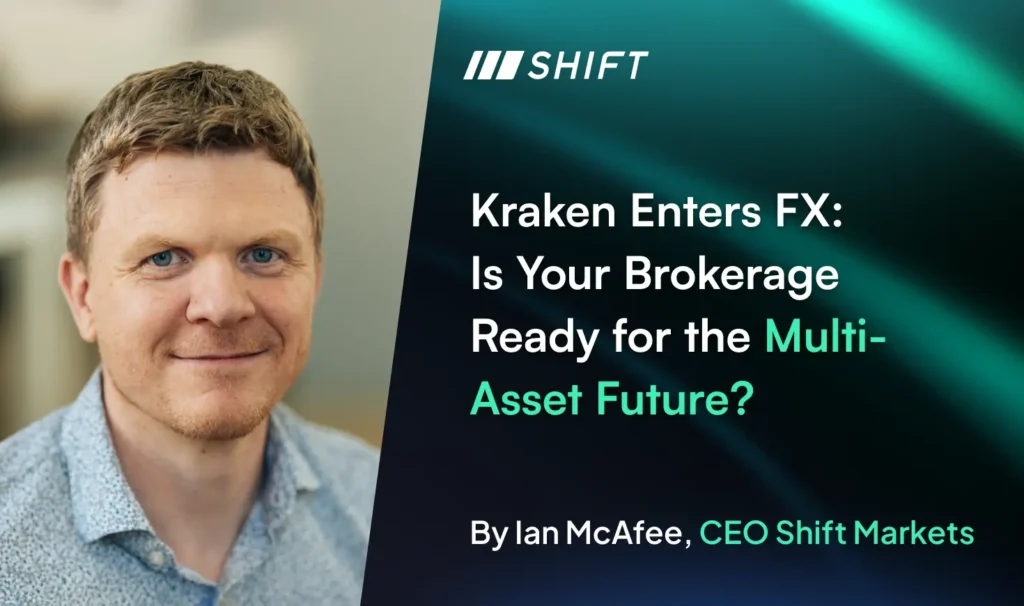Summarize with AI:
Read the original publication of this article here.
The brokerage industry is facing another transformational shift, similar to the rise of MetaTrader 4 in retail FX over a decade ago. Around 2010, MetaTrader 4 emerged as a dominant force. Many brokers who embraced this trend and offered MT4 gained significant market share, benefiting from its widespread adoption and features like automated trading. Conversely, brokers who resisted, opting to build proprietary platforms or stick with outdated technology, often found themselves losing ground. Today, we’re seeing a similar dynamic unfold.
The new standard is integrated, web and mobile-first multi-asset platforms that incorporate cryptocurrencies alongside traditional assets like FX. Building such sophisticated, compliant, and user-friendly platforms requires a vastly different skillset than running a brokerage. It demands dedicated technological expertise, significant investment, and continuous innovation – resources most brokers simply cannot divert from their core business.
Recent industry moves paint a clear picture. Crypto exchange giant Kraken recently launched FX perpetual futures, directly competing with traditional FX brokers and exemplifying a broader trend of convergence. This follows Kraken’s $1.5B acquisition of NinjaTrader and announcements from giants like Charles Schwab planning spot Bitcoin trading.
As Drew Niv, former CEO of FXCM, observed, the lines are blurring as crypto players aggressively expand into traditional brokerage territory, directly challenging established players and potentially siphoning off clients seeking broader asset access. This intensifies existing pressures on FX/CFD brokers facing margin compression in their core offerings.
This development addresses surging demand in a rapidly maturing market, extending well beyond competitive pressures. The sheer scale is undeniable: derivatives dominate digital asset trading, accounting for over 70% of a staggering $3.5 trillion traded monthly – a figure Coinbase Research expects to hit $5 trillion monthly by year-end. From a high level, over 60% of this volume now comes from institutional investors, with 82% planning to increase their crypto allocation by 2026. They, along with sophisticated retail traders, are actively seeking unified, multi-asset trading experiences.
Simultaneously, regulatory hurdles are diminishing and transforming into catalysts. Favorable regulatory tailwinds are emerging globally. In Europe, the comprehensive MiCA framework provides essential clarity for service providers. In the US, potential shifts like the SAB 121 rescission could ease bank participation, while significant legislative efforts like the Financial Innovation and Technology for the 21st Century Act (FIT21) aim to establish clearer jurisdictional boundaries and operating rules. This global trend towards regulatory clarity creates a prime window for strategic integration.
The traditional product silo is obsolete. Modern traders, particularly younger ones comfortable with digital platforms, demand easier movement between asset classes. Ignoring this shift risks client migration; the 62% of active traders under 40 already juggling separate traditional and crypto accounts highlight the unmet need for integrated solutions.
Looking deeper, a significant operational reality, especially stark in regions like Asia where it can exceed 50-70%, is the high percentage of FX/CFD deposits made via cryptocurrency. This forces clients to first interact with crypto exchanges – increasingly direct competitors launching their own FX offerings – simply to fund their brokerage accounts. Relying on competitors for client onboarding and funding is a precarious position. Offering crypto perpetuals alongside FX CFDs isn’t just a product extension; it’s about controlling the client journey and reducing reliance on external, competing platforms.
Successfully transitioning to multi-asset trading requires specialized technology. Brokers need compliant platforms supporting spot and derivatives trading across multiple asset classes, along with deep liquidity for competitive pricing. Developing these capabilities internally can be costly, time-consuming, and distracts from core brokerage operations.
Given the operational and compliance complexities involved, many brokers choose to work with external technology providers experienced in integrating digital assets with traditional finance. This approach enables brokers to implement necessary infrastructure efficiently, accelerate time-to-market, and stay focused on serving their clients.
The decisions made today will determine your brokerage’s relevance tomorrow. The convergence of traditional and digital assets isn’t a future event; it’s the current reality demanding action. Brokers who proactively adapt, leveraging proven technology and expertise, will be best positioned to thrive in this changing market.
Here are some specific solutions Shift Markets designed to address the challenges discussed:
- Launch a competitive crypto derivatives offering quickly: Deploy Ready-to-Use Crypto Derivatives Trading Platforms
- Stop sending clients to competitors for deposits: Simplify Deposits with Integrated Crypto Payment Solutions
Share this article:
Want to learn more?
Let us save you time by walking you through what Shift can do for your business!
